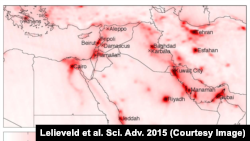A new study shows air pollution has declined throughout the Middle East since 2010. Researchers say that reflects problems on the ground.
Researchers couldn't explain the lowered pollution rates just on new air quality control regulations put in place by some Middle Eastern States.
So they looked at the amount of political strife and economic decline in the region. They found a match between troubles on the ground after 2010, and lower air pollution throughout the Middle East over the past decade.
Greek, German and Saudi scientists say atmospheric concentrations of the pollutant nitrogen oxide being detected by the low Earth orbiting satellite, the Ozone Monitoring Instrument or OMI, went on a steep decline in places where there’s been significant conflict and political upheaval.
Jos Lelieveld of the Max Planck Institute in Germany says this is particularly evident in Iraq where the terrorist organization, the Islamic State, is wreaking havoc.
“North, northwest of Baghdad where the Islamic State is active, we see where pollution is going down. So, people are moving out of there. And you can actually see where these people are moving to," said Lelieveld.
Nitrogen oxides, or NOs, include fine particulate air pollution from common road traffic exhaust and energy production.
In an article in the journal Science Advances, the scientists tell how they compared satellite data with economic and energy data from the World Bank and the US Energy Information Administration.
At a teleconference sponsored by Science Magazine and AAAS, Lelieveld explained they took note of numbers showing pollution going down, even in areas where booming economies and other signs of growth should have shown the exact opposite.
Normally, growing economies mean dirtier air.
Lelieveld concluded that predictions of economic growth can be inaccurate, because they rely on long-term projections, and can't take into account the sometimes quickly changing situations in the real world.
“We just find that these are simply not good predictors for trends, at least not in the Middle East," he said.
OMI measurements also found steep declines in air pollution since 2008 in Greece, probably as a result of the country’s economic and political crisis.
Over Iran, the scientists say declines in NO emissions are likely connected to strong Western economic sanctions.
They also say environmental controls have played a role in lowering pollution levels, notably in Israel and Arabian Gulf countries, and suggest that policy-makers keep an eye on the sky from space.





